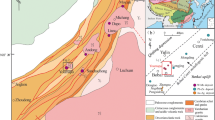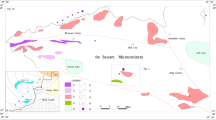Abstract
The Wenquan molybdenum deposit is associated with a Triassic granite in this area. The Wenquan granite is enriched in LILE and LREE, poor in HFSE, and has significantly higher contents of alkali (K2O+Na2O) and Sr, Ba than those of the island arc volcanic rocks. These geochemical characteristics are similar to post-collisional granites in high K calc-alkaline series. Studies of major elements, trace elements, REEs and chronology of the Wenquan pluton show that, in the geodynamic transition stage of continent-continent convergence to extension, the partial melting of the enriched lithospheric mantle generated the basaltic magma and triggered the partial melting of the thickened lower crust which produceded the acidic magma, and the Wenquan pluton was formed by mixing of the two magmas. Molybdenite Re-Os isotopic dating gave Os model ages of 212.7±2.6 Ma to 215.1±2.6 Ma with a weighted mean of 214.1±1.1 Ma, and an Re-Os isochron age of 214.4±7.1 Ma. These ages are close to K-Ar ages (223 to 226 Ma) and a SHRIMP zircon U-Pb age (223±7 Ma) for the Wenquan granite within the error range, but relatively younger. This implies that the Mo mineralization occurred in a late stage of the magmatic intrusion, and the metallogenesis took place in the transition stage from syn-collision to post-collision in the tectonic setting of the Qinling Orogenic Belt (QOB) after continental collision between the North China Block (NCB) and the South China Block (SCB). This process is also corresponding to the geological events of metamorphism and deformation in South Qinling, closure of the Mian-Lue oceanic basin, and exhumation of the Dabie-Sulu ultrahigh-pressure metamorphic rocks. The large-scale continent-continent collision between NCB and SCB in the middle Triassic triggered significant crustal thickening and exhumation of subducted slab. In the late Triassic, the tectonic setting was transformed to the transition stage from collision to extension. Materials from the asthenospheric mantle would ascend into the root of the lower crust, which could induce partial melting of the lower crust and generate Mo-enriched granitic magma. The ore-forming elements enriched in the fluid derived from the condensation and fraction of the magma resulted in the Mo mineralization. The Mo deposits in the QOB are mainly formed in two episodes, namely 220± Ma and 140± Ma. The two episodes of metallogenesis were developed in the tectonic transition settings from compression to extension, but they were in the different stages of the tectonic evolution. The occurrence of the Wenquan Mo-bearing pluton indicates that the Triassic tectonic-magmatic belt of Western Qinling is another favorable region for Mo mineralization in the QOB. Therefore, it is significant to pay more attention to evaluation of the ore-forming potentiality in the Triassic granites in Western Qinling.
Similar content being viewed by others
References
Zhang G W, Zhang B R, Yan X C, et al. Qinling Orogenic Belt and Continental Dynamics (in Chinese). Beijing: Science Press, 2001. 1–729
Zhang H F, Jin L L, Zhang L, et al. Geochemical and Pb-Sr-Nd isotopic compositions of granitoids from western Qinling belt: Constraints on basement nature and tectonic affinity (in Chinese). Sci Chin Ser D-Earth Sci, 2007, 50(2): 184–196
Meng Q R, Zhang G W. Geologic framework and tectonic evolution of the Qinling orogen, central China. Tectonophysics, 2000, 323: 183–196
Li N, Chen Y J, Zhang H, et al. Molybdenum deposits in East Qinling (in Chinese). Earth Sci Front, 2007, 14(5): 186–198
Li Y F, Mao J W, Liu D Y, et al. SHRIMP zircon U-Pb and molybdenite Re-Os dating for the Leimengou porphyry molybdenite deposit, Western Henan and its Geological implication (in Chinese). Geol Rev, 2005, 52(1): 122–131
Zhang Z W, Zhu B Q, Chang X Y, et al. Petrogenetic-Metallogenetic Background and Time-Space Relationship of the East Qinling Molybdenum Ore Belt, China (in Chinese). Geol J Chin Univ, 2001, 7(3): 307–315
Hu S X, Lin Q L, Chen Z M, et al. Geology and Metallogenesis of Collage Zone of North China Block and South China Block (in Chinese). Nanjing: Nanjing University Press, 1988. 442–489
Chen Y J, Li C, Zhang J, et al. Sr and O isotopic characteristics of porphyries in the Qinling molybdenum deposit belt and their implication to genetic mechanism and type. Sci Chin Ser D-Earth Sci, 2000, 43(Supp): 82–94
Luo M J, Zhang F M, Dong Q Y, et al. Chinese Molybdenum Deposit (in Chinese). Zhengzhou: Henan Science and Technology Press, 1991. 1–408
Zhu L M, Zhang G W, Guo B, et al. U-Pb (LA-ICP-MS) zircon dating for the large Jinduicheng porphyry Mo deposit in the East Qinling, China, and its metallogenetic geodynamical Setting (in Chinese). Acta Geol Sin, 2008, 82(2): 204–220
Chen Y J, Fu S G. Metallogenic Regularity of Gold Deposit in Western Henan (in Chinese). Beijing: Seismological Press, 1992. 1–234
Zhang B R, Zhang H F, Zhao Z D, et al. Geochemical subdivision and evolution of the lithosphere in East Qinling and adjacent regions. Implications for tectonics (in Chinese). Sci Chin Ser D-Earth Sci, 1996, 39(3): 245–253
Stein H J, Markey R J, W Morgan J, et al. Highly precise and accurate Re-Os ages for molybdenite from the East Qinling molyb denum belt, Shaanxi Province, China. Econ Geol, 1997, 92: 827–835
Huang D H, Wang Y C, Nie F J, et al. A sort of new stype of molybdenite deposit The geological features and metallogenic mechanism of huanglongpu carbonatitc vein-type molybdenum (Lead) deposit, Shaanxi Province (in Chinese). Acta Geol Sin, 1985, 59(3): 241–257
Huang D H, Wu C Z, Du A D, et al. Metallochronology of molybdenum (copper) deposit in the North China platform: Re-Os age of molybdenite and its geological significance (in Chinese). Min Dep, 1996, 15(4): 365–373
Lu X X, Yu Z P, Feng Y L, et al. Mineralization and tectonic setting of deep-hypabyssal granites inn east Qinling mountain (in Chinese). Min Dep, 2002, 21(2): 168–178
Han H T, Liu J S, Dong X, et al. The geochemistry characteristic for Granitoid of Wenquan molybdenite deposit in West Qinling (in Chinese). Geoph Geochem Expl, 2008, 32(2): 132–153
Lu X X, Xiao Q H, Dong Y, et al. The Tectonic Map About Granites of Qinling (in Chinese). Beijing: Geological Publishing House, 1998. 10–120
Li X Z, Yan Z, Lu X X. Granites of Qinling-Dabie Mountain (in Chinese). Beijing: Geological Publishing House, 1993. 1–215
Li Y J, Gao Z H, Li Y, et al. The geochemical features of the Wenquan magma-mingling granite in Western Qinling (in Chinese). Geol Geochem, 2003, 31(4): 43–49
Batchlor R B, Bowden P. Petrogenetic interpretation of granitiod rock series using multicationic parameters, Chem Geol, 1985, 48: 43–55
Sun S S, McDonough W F. Chemical and isotopic systematics of oceanic basalts: Implication for the mantle composition and process. Saunder A D, Norry M J, eds. Magmatism in the Ocean Basins. London: Geological Society Special Publication, 1989. 313–345
Harris N B W, Pearce J A, Tindle A G. Geochemical characteristics of collision—Zone magmatism. In: Cowed M P, Reis A C, eds. Collision Tectonics. London: Geological Society Special Publication, 1986. 67–81
Pearce J A. Sources and settings of granitic rocks. Episodes, 1996, 19: 120–125
Pearce J A, Haltis H B W, Tindele A G. Trace element discrimination diagrams for the tectonic interpretation of granitic rocks. J Petrol, 1984, 25: 956–983
Du A D, Wu S Q, Sun D Z, et al. Preparation and Certification of Re-Os Dating Reference Materials: Molybdenite HLP and JDC. Geos Geoanal Res, 2004, 28(1): 41–52
Qu W J, Du A D. Correction of mass discrimination in the determination of the isotope abundance for rhenium and osmium in molybdenite by inductively coupled plasma mass spectrometry (in Chinese). J Chin Mass Spec Soc, 2004, 25(Supp.): 181–182
Ludwig K R. ISOPLOT: A plotting and regression program for radiogenic—isotope data. US Geological Survey Open-File Report. diogenic—isotope data. US Geological Survey Open-File Report. 1991. 39
Foster G, Lambert D D, Frick I R, et al. Re-Os isotopic evidence for genesis of Archaean nickel ores from uncontaminated komatiites. Nature, 1996, 382: 703–706
Sun W D, Li S G, Chen Y D, et al. Timing of synorogenic synorogranotoids in the south Qinling, central China: Constraints on the evolution of the Qinling-Dahie Orogenic Belt. J Geol, 2002, 110: 457–468
Li S G, Sun W D, Zhang G W, et al. The chronology and geochemistry characteristics of metamorphic volcanic rock in Heigouxia of Mian-Lue suture zone, Southern Qinling—the evidence of Paleozoic ocean basin and the close age (in Chinese). Sci Chin Ser D-Earth Sci, 1996, 26(3): 223–230
Li S G, Xiao Y L, Liu D L. Collision of the North China and Yangtze Blocks and form action of coesite-bearing eclogites: Timing and processes. Chem Geol, 1993, 27(3): 89–111
Qin J F, Lai S C, Li Y F. Petrogenesis and geological significance of Yangba granodiorites from Bikou area, Northern margin of Yangtze Plate (in Chinese). Acta Petrol Sin, 21(3): 697–710
Lai S C, Zhang G W, Dong Y P, et al. Geochemistry and regional distribution of ophiolites and associated volcanics in Mianlue suture, Qinling-Dabie Mountain (in Chinese). Sci Chin Ser D-Earth Sci, 2003, 33: 1174–1183
Zhang G W, Cheng S Y, Guo A L, et al. Mianlue paleo-suture on the southern margin of the Central Orogenic Sytem in Qinling-Dabie—With a discussion of the assembly of the main part of the continent of China (in Chinese). Geol Bull Chin, 2004, 23(9-10): 846–853
Bonin B. Do coeval mafic and felsic magmas in post-collisional to within-plate regimes necessarily imply two contrasting, mantle and crustal, sources? A review. Lithos, 1999, 78(1-2): 1–24
Barbarin B. A review of the relationship between granitoids types, their origins and their geodynamic environments. Lithos, 1999, 46: 605–626
Liegeios J P. Preface-Some words on the post-collisional magmatism. Lithos, 1998, 45: 15–17
Roger J J W, Greenberg J K. Late-orogenic, post-orogenic and anorogenic granites: distinction by major-element and trace-element chemistry and possible origins. J Geol, 1990, 98: 291–309
Zheng Y F. A perspective view on ultrahigh pressure metamorphism and continental collision in the Dabie-Sulu orogenic belt. Chin Sci Bul, 2008, 53(20): 3081–3104
Hacker R B, Ratsehbacher L, Webb L. U-Pb zircon ages constrain the architecture of the ultrahigh-pressure Qinling-Dabie Orogen, China. Earth Planet Sci Lett, 1998, 161: 215–230
Li S G, Li H, Chen Y. Chronology of ultrahigh-pressure metamorphism in the Dabie Mountains and Su-Lu terrene: II. U-Pb isotope system of zircon. Sci Chin Ser D-Earth Sci, 1997, 27(3): 200–206
Zheng Y F, Chen R X, Zhao Z F. Chemical geodynamics of continental subduction-zone metamorphism: insights from studies of the Chinese Continental Scientific Drilling (CCSD) core samples. Tectonophysicsics, 2009, 464, doi:10.1016/j.tecto.2008.09.014
Wang X X, Wang T, Lu X X, et al. Laojunshna and Qinlingliang rapakivi-textured granitoids in North Qinling and their tectonic setting: A possible orogenic-type rapakivi granitoids (in Chinese). Acta Petrol Sin, 2003, 19(4): 650–660
Lu X X, Yu X D, Xiao Q H, et al. geochronological studies of rapakivi granites in Qinling and its geological implications (in Chinese). Geol J Chin Univ, 1999, 5(4): 373–377
Sylvesler P J. Post-collisional strongly peraluminous granites. Lithos, 1998, 45: 29–44
Wang T, Wang X X, Li W P. Evaluation of multiple emplacement mechanisms of Huichizi granite pluton, Qinling orogenic belt, central China. J Struct Geol, 2000, 22(4): 505–518
Jamieson R A. P-T-t paths of collisional orogenesis. Geol Rund, 1991, 180: 321–332
Chen Y J. Orogenic-type deposit, metallogenic model and ore prospecting potential (in Chinese). Geol Chin, 2006, 33(6): 1181–1196
Author information
Authors and Affiliations
Corresponding author
Additional information
Supported by National Basic Research Program of China (Grant No. 2006CB403502), National General Investigation Program of China (Grant No. 1212010631007), National Natural Science Foundation of China (Grant No. 40872071), Foundation of State Key Laboratory of Ore Deposit Geochemistry, Chinese Academy of Sciences (Grant No. 20060), Foundation of Educational Bureau of Shaanxi Province Foundation (Grant No. 07JK414) and Foundation of the State Key Laboratory for Mineral Deposits Research, Nanjing University (Grant No. 14-08-1)
About this article
Cite this article
Zhu, L., Ding, Z., Yao, S. et al. Ore-forming event and geodynamic setting of molybdenum deposit at Wenquan in Gansu Province, Western Qinling. Chin. Sci. Bull. 54, 2309–2324 (2009). https://doi.org/10.1007/s11434-009-0094-6
Received:
Accepted:
Published:
Issue Date:
DOI: https://doi.org/10.1007/s11434-009-0094-6




